Experimental Study on Influence of Lime on Cross-Scale Characteristics of Cemented Backfill with Multiple Solid Wastes
Abstract
:1. Introduction
2. Scheme Design
2.1. Raw Materials
2.2. Experimental Method
3. Results
3.1. UCS Attribute
3.2. NMR Characteristic
3.3. SEM Analysis
3.4. AC Impedance Characteristic
4. Discussion and Analysis
4.1. Pore Characteristics Analysis
4.2. The Relationship between UCS and Pore Parameters
4.2.1. The Relationship between UCS and Pore Content
4.2.2. The Relationship between UCS and Fractal Dimension
4.3. The Influence Law of Liquid Content on Impedance
4.4. The Influence Law of Impedance on UCS
5. Conclusions
- (1)
- Under the action of lime, FA undergoes a pozzolash reaction to produce C-S-H gelling and C-A-H crystals. C-A-H crystals then react with PG to produce AFt, which is similar to the hydration reaction of cement.
- (2)
- The industrial solid waste under the action of lime has an optimized strength effect. The addition of 1.8% lime can increase the strength by 21.57%, indicating that the hydration product of industrial solid waste has a filling effect, resulting in a 17.88% reduction in the backfill porosity. The hydration product also has a bonding effect, so the strength is increased.
- (3)
- Fractal characteristics reflect the complexity of pores. The larger the pore size, the larger the fractal dimension, indicating that the pores are more complex. The fractal dimension is between 0.21 and 1.04 and first decreases and then increases with the increase in lime content.
- (4)
- The cross-scale relationship of strength is established. The results show that strength is inversely proportional to various types of pore contents and fractal dimensions and increases logarithmically with impedance at different frequencies. The lower the frequency, the stronger the relationship is.
Author Contributions
Funding
Institutional Review Board Statement
Informed Consent Statement
Data Availability Statement
Conflicts of Interest
References
- Lin, W.; Wang, H.; Liu, D.; Xing, H.; Liu, C.; Zhang, Y.; Li, S. Research progress on granulation process of iron and steel slag. Metall. Res. Technol. 2022, 119, 120. [Google Scholar] [CrossRef]
- Sun, H.K.; Gan, D.Q.; Xue, Z.L.; Liu, Z.Y.; Zhang, Y.J. Early mechanical properties and energy evolution characteristics of alkali slag modified backfill. Mater. Rep. 2024, 38, 22070248. [Google Scholar]
- Wu, W.L.; Xu, W.B. Experimental study on the effect of saturation on the triaxial mechanical properties of cemented tailings backfill. J. Cent. S. Univ. (Sci. Technol.) 2023, 54, 4015–4029. [Google Scholar]
- Zhou, Q.; Zhang, Y.; Liu, J.; Wu, A.; Wang, H. Research and Application Status and Development Trend of Alkali-Activated Binder Powder for Mine Backfill. J. Renew. Mater. 2022, 10, 3185–3199. [Google Scholar] [CrossRef]
- Tang, C.; Mu, X.; Ni, W.; Xu, D.; Li, K. Study on Effects of Refining Slag on Properties and Hydration of Cemented Solid Waste-Based Backfill. Materials 2022, 15, 8338. [Google Scholar] [CrossRef] [PubMed]
- Li, L.T.; Gao, Q.; Xiao, B.L.; Wen, Z.J.; Wu, F. Review and Application Prospects of Filling Cementitious Materials Developed by Industrial Solid Waste. Min. Res. Dev. 2020, 40, 19–25. [Google Scholar]
- Zou, M.; Shen, Y.; Liu, J.H. Review on application of steel slag powder in cement-based materials. Bull. Chin. Ceram. Soc. 2021, 40, 2964–2977. [Google Scholar]
- Zhang, S.K.; Yang, H.J.; Fu, K.; Guo, C.Y.; Ma, X.H.; Yao, F.; Xiao, H.R.; Liu, J.J. Research on the development and performance test of phosphogypsum filling materials for mines. Min. Saf. Environ. Prot. 2024, 51, 133–139. [Google Scholar]
- Wang, Y.W. Experimental study on influence of fly ash on backfill strength of Sanshandao gold mine. Chin. Min. Mag. 2020, 29, 137–140. [Google Scholar]
- Yin, X.; Ma, L.; Li, K.; Du, W.; Hou, P.; Dai, Q.; Xiong, X.; Xie, L. Preparation of phosphogypsum-based cemented paste backfill and its environmental impact based on multi-source industrial solid waste. Constr. Build. Mater. 2023, 404, 133314. [Google Scholar] [CrossRef]
- Zhou, Y.N.; Shi, Y.; Zhu, Q.Q. Control of Fluoride Pollution in Cemented Phosphogypsum Backfill by Citric Acid Pretreatment. Materials 2023, 16, 6493. [Google Scholar] [CrossRef]
- Zhou, Y.; Li, X.; Shi, Y.; Zhu, Q.; Du, J. Reuse of phosphogypsum pretreated with water washing as aggregate for cemented backfill. Sci. Rep. 2022, 12, 16091. [Google Scholar] [CrossRef] [PubMed]
- Zhou, X.H.; Zhao, Y.H.; Zhu, H.Y.; Zhou, Q.S. Performance activation and strength evolution mechanism of carbide slag on anhydrous phosphogypsum backfill material. Constr. Build. Mater. 2024, 419, 135503. [Google Scholar] [CrossRef]
- Jiang, G.Z.; Wu, A.X.; Wang, Y.M.; Lan, W.T. Low cost and high efficiency utilization of hemihydrate phosphogypsum: Used as binder to prepare filling material. Constr. Build. Mater. 2018, 167, 263–270. [Google Scholar] [CrossRef]
- Liang, Z.Q. Review on Development and Application of New Type Backfiling Cementing Materials in Mining industry. Met. Mine 2015, 6, 164–170. [Google Scholar]
- Wang, Y.; Wu, J.; Ma, D.; Pu, H.; Yin, Q.; Chen, W. Study on macro-meso mechanical properties of cemented tailings backfill with high fly ash content. Environ. Sci. Pollut. Res. 2023, 30, 2904–2917. [Google Scholar] [CrossRef]
- Behera, S.K.; Ghosh, C.N.; Mishra, D.P.; Singh, P.; Mishra, K.; Buragohain, J.; Mandal, P.K. Strength development and microstructural investigation of lead-zinc mill tailings based paste backfill with fly ash as alternative binder. Cem. Concr. Compos. 2020, 109, 103553. [Google Scholar] [CrossRef]
- Shao, X.; Sun, J.; Xin, J.; Zhao, B.; Sun, W.; Li, L.; Tang, R.; Tian, C.; Xu, B. Experimental study on mechanical properties, hydration kinetics, and hydration product characteristics of aeolian sand paste-like materials. Constr. Build. Mater. 2021, 303, 124601. [Google Scholar] [CrossRef]
- James, J.; Arthi, C.; Balaji, G.; Chandraleka, N.; Naveen Kumar, R.H.M. Lime activated fly ash-phosphogypsum blend as a low-cost alternative binder. Int. J. Environ. Sci. Technol. 2022, 19, 8969–8978. [Google Scholar] [CrossRef]
- Hu, J.; Zhao, F.; Kuang, Y.; Yang, D.; Zheng, M.; Zhao, L. Microscopic characteristics of the action of an air entraining agent on cemented paste backfill pores. Alex. Eng. J. 2020, 59, 1583–1593. [Google Scholar] [CrossRef]
- Liu, L.; Fang, Z.; Qi, C.; Zhang, B.; Guo, L.; Song, K.I. Experimental investigation on the relationship between pore characteristics and unconfined compressive strength of cemented paste backfill. Constr. Build. Mater. 2018, 179, 254–264. [Google Scholar] [CrossRef]
- Chen, J.; Zhao, H.; Zhao, M.; Peng, W.; Hou, J. Prediction of permeability for fully weathered granite amended with fly ash by fractal dimensions. J. Sustain. Cem.-Based Mater. 2023, 12, 259–270. [Google Scholar] [CrossRef]
- Chai, S.; Tian, M.; Wei, L.; Zhang, L. The water stability and microstructure indices of sulphate saline soil stabilized with lime and fly ash. J. Eng. Geol. 2024, 32, 430–439. [Google Scholar]
- Yang, P.; Suo, Y.; Liu, L.; Qu, H.; Xie, G.; Zhang, C.; Deng, S. Study on the curing mechanism of cemented backfill materials prepared from sodium sulfate modified coal gasification slag. J. Build. Eng. 2022, 62, 105318. [Google Scholar] [CrossRef]
- Dong, B.; Zhuang, Z.; Gu, Z.; Wu, Y.; Teng, X.; Xing, F.; Hong, S. Electrochemical impedance spectroscopy analysis of Cl− penetration in slag concrete. J. Shenzhen Univ. Sci. Eng. 2019, 36, 268–273. [Google Scholar]
- Xu, W.; Tian, X.; Qiu, Y.; Dang, P.; Yin, T. Experiment of the resistivity characteristic of cemented backfill mass during the whole consolidation process. J. Chin. Univ. Min. Technol. 2017, 46, 265–272+344. [Google Scholar]
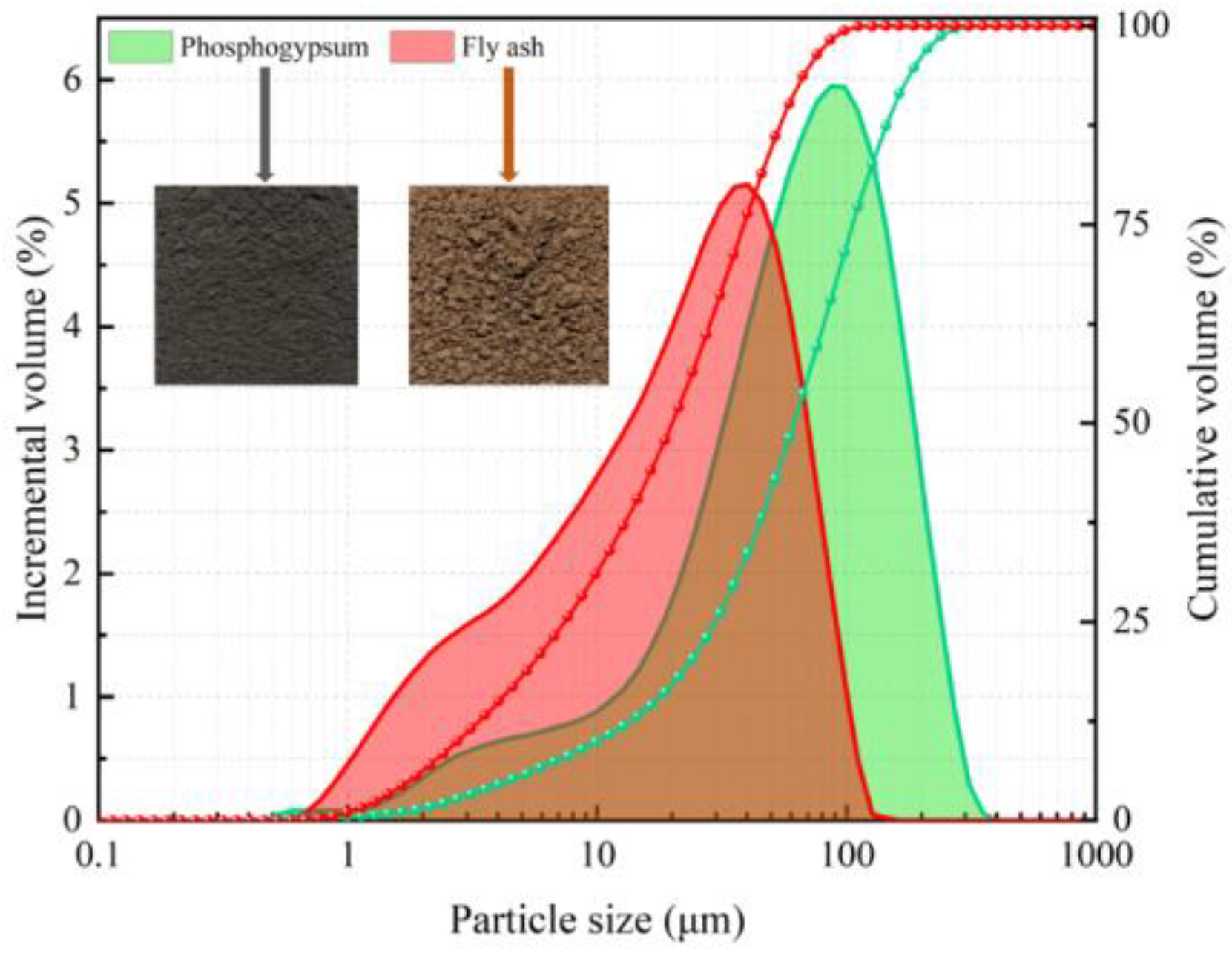
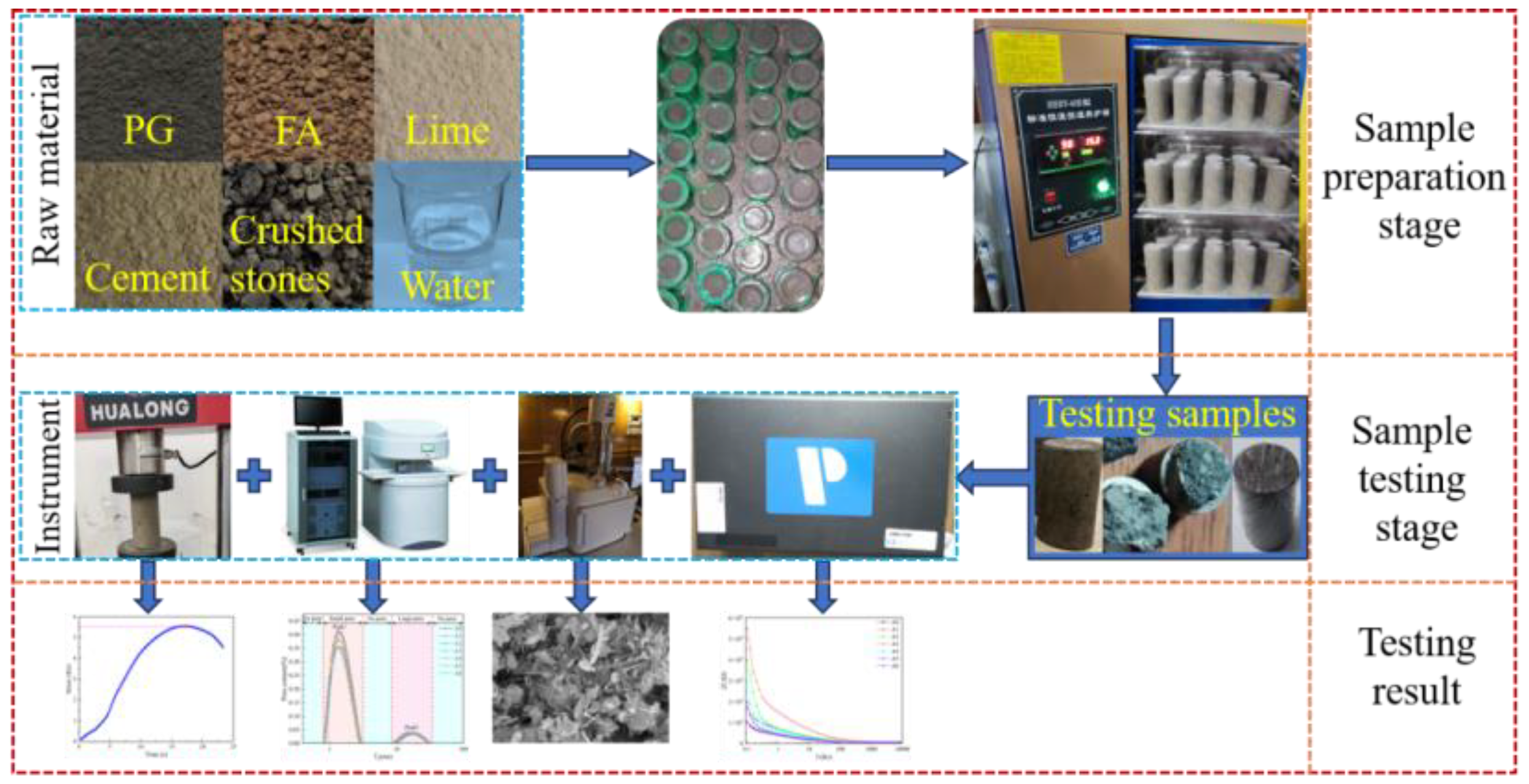

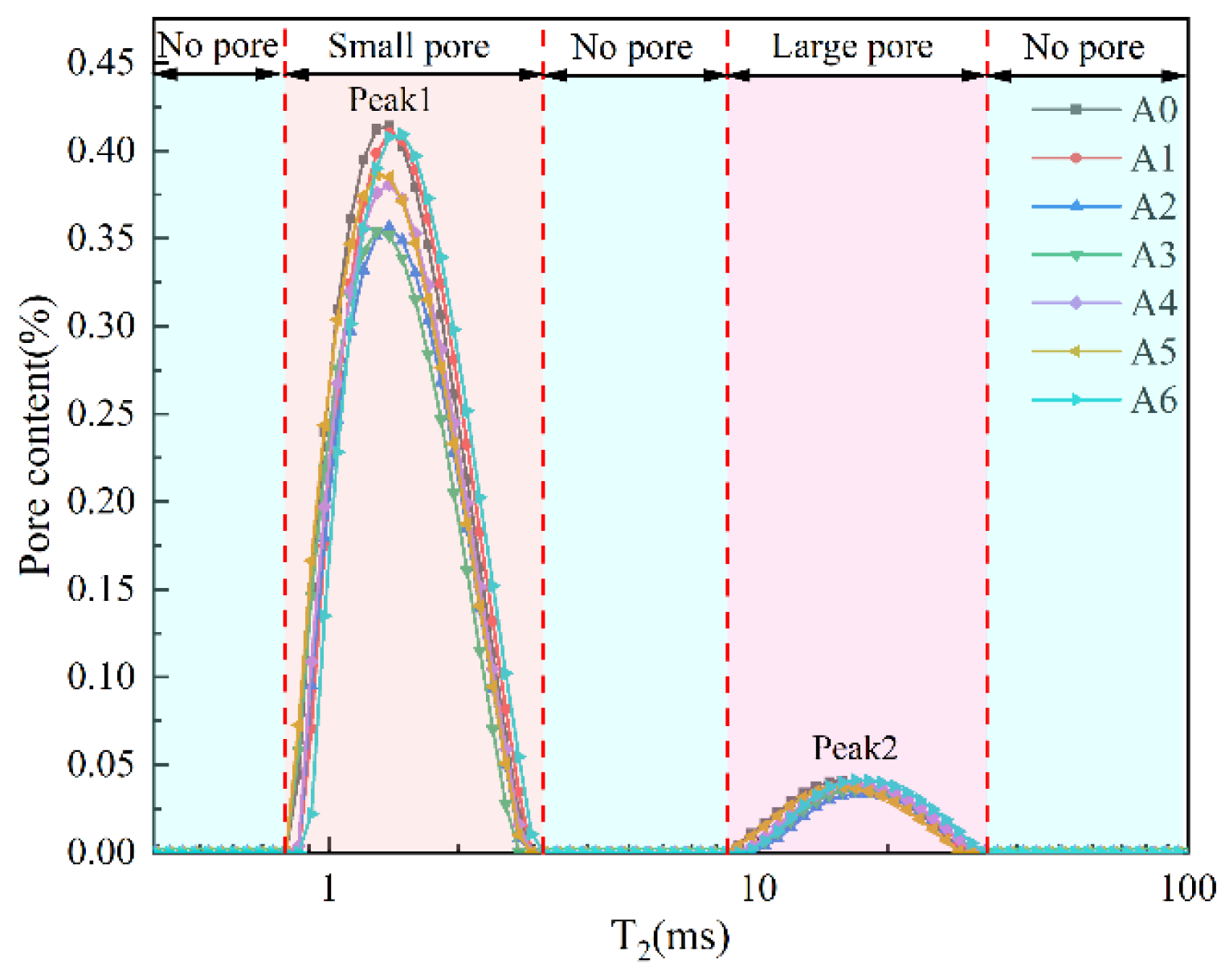
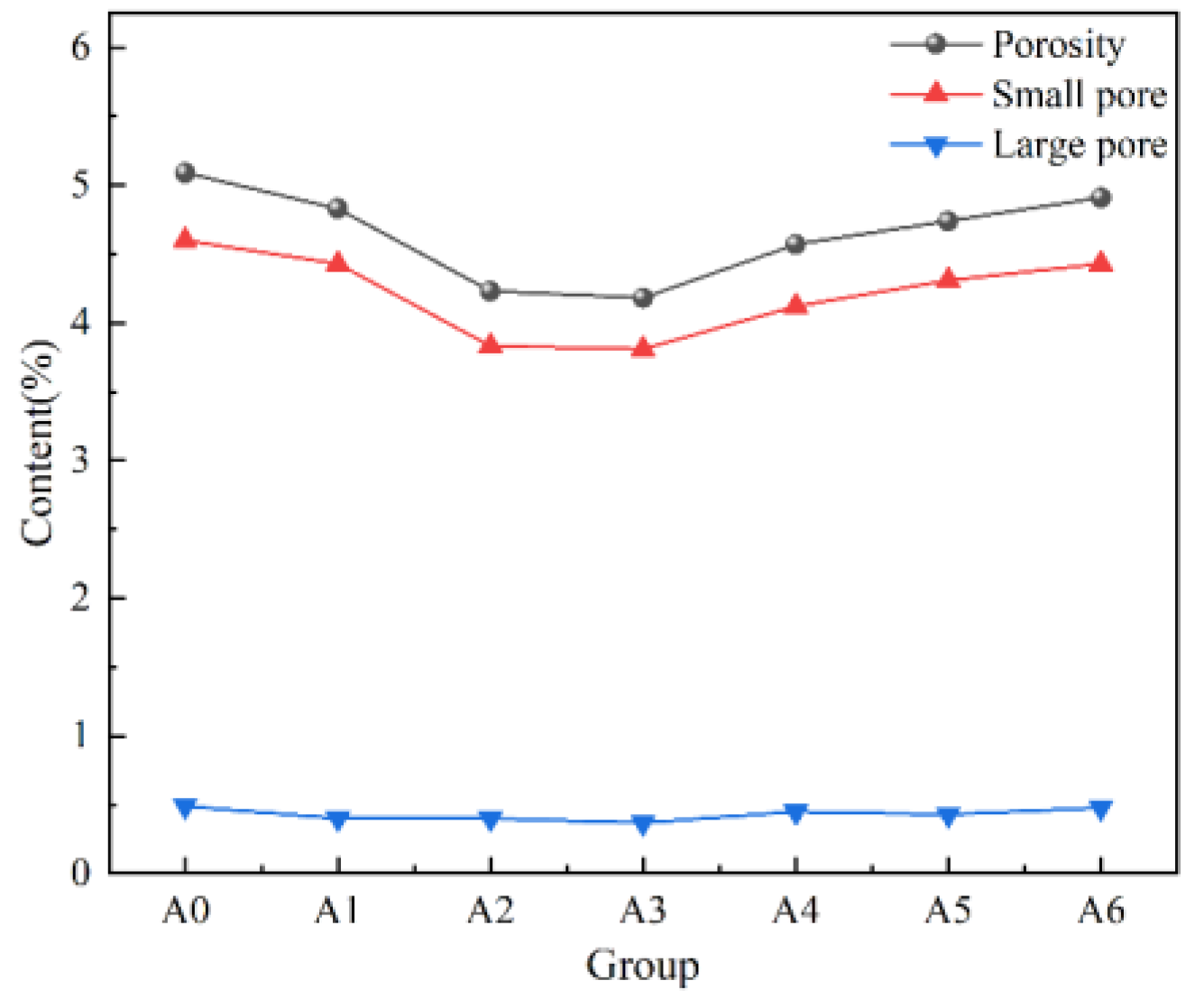
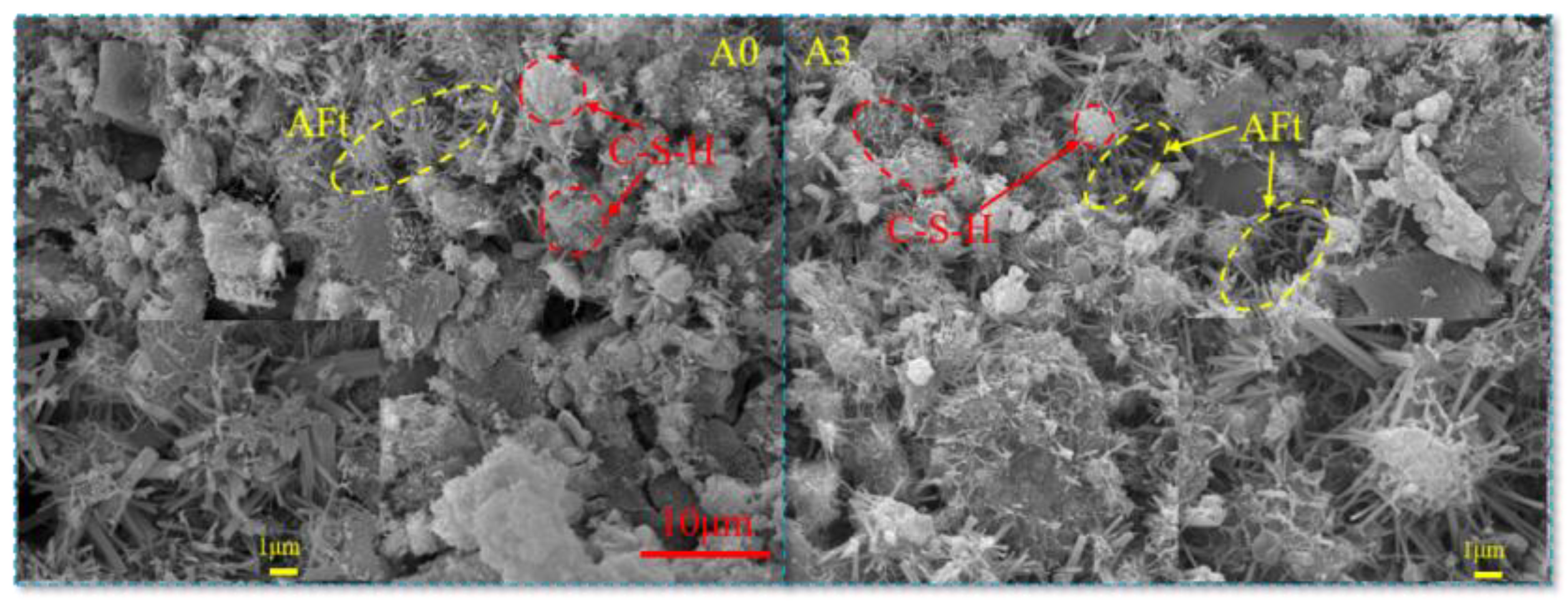
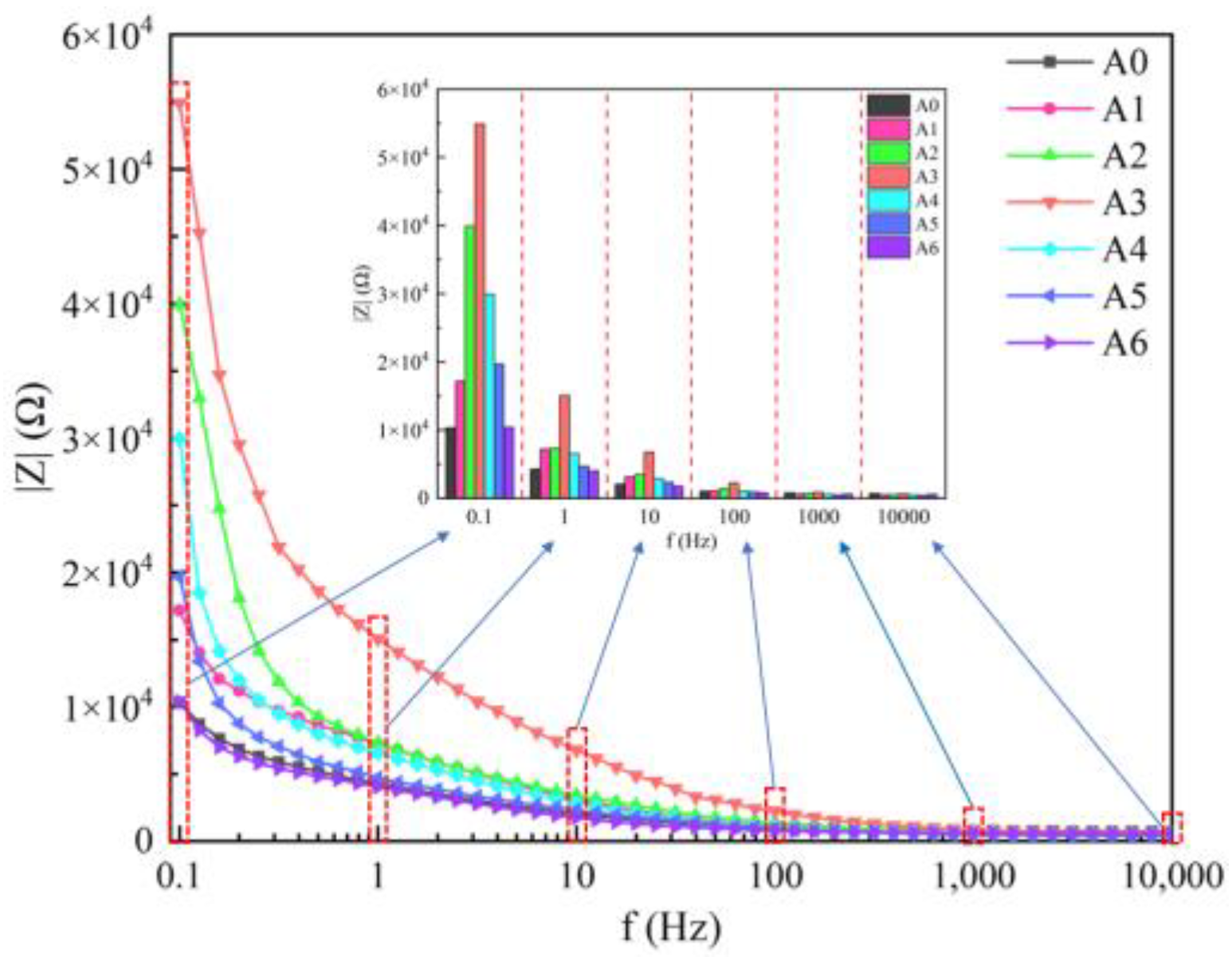
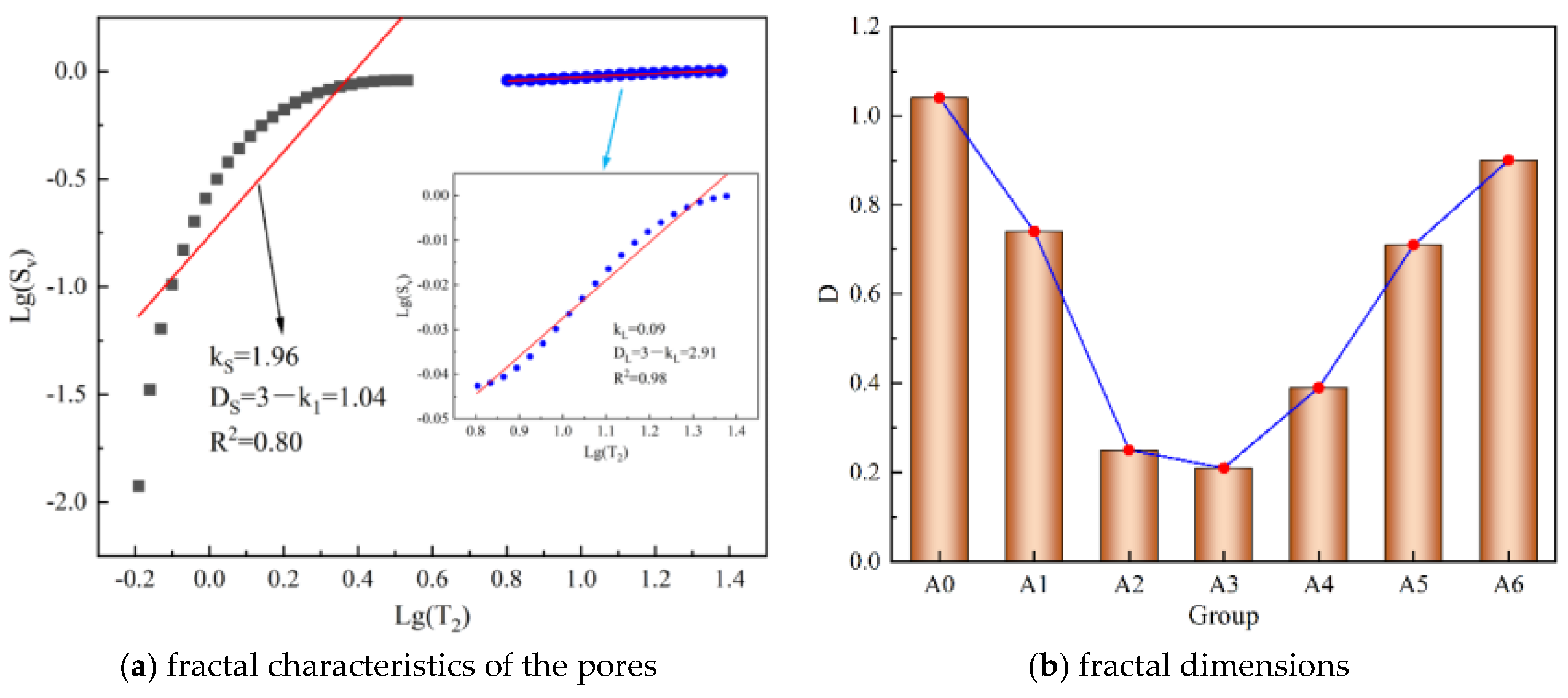
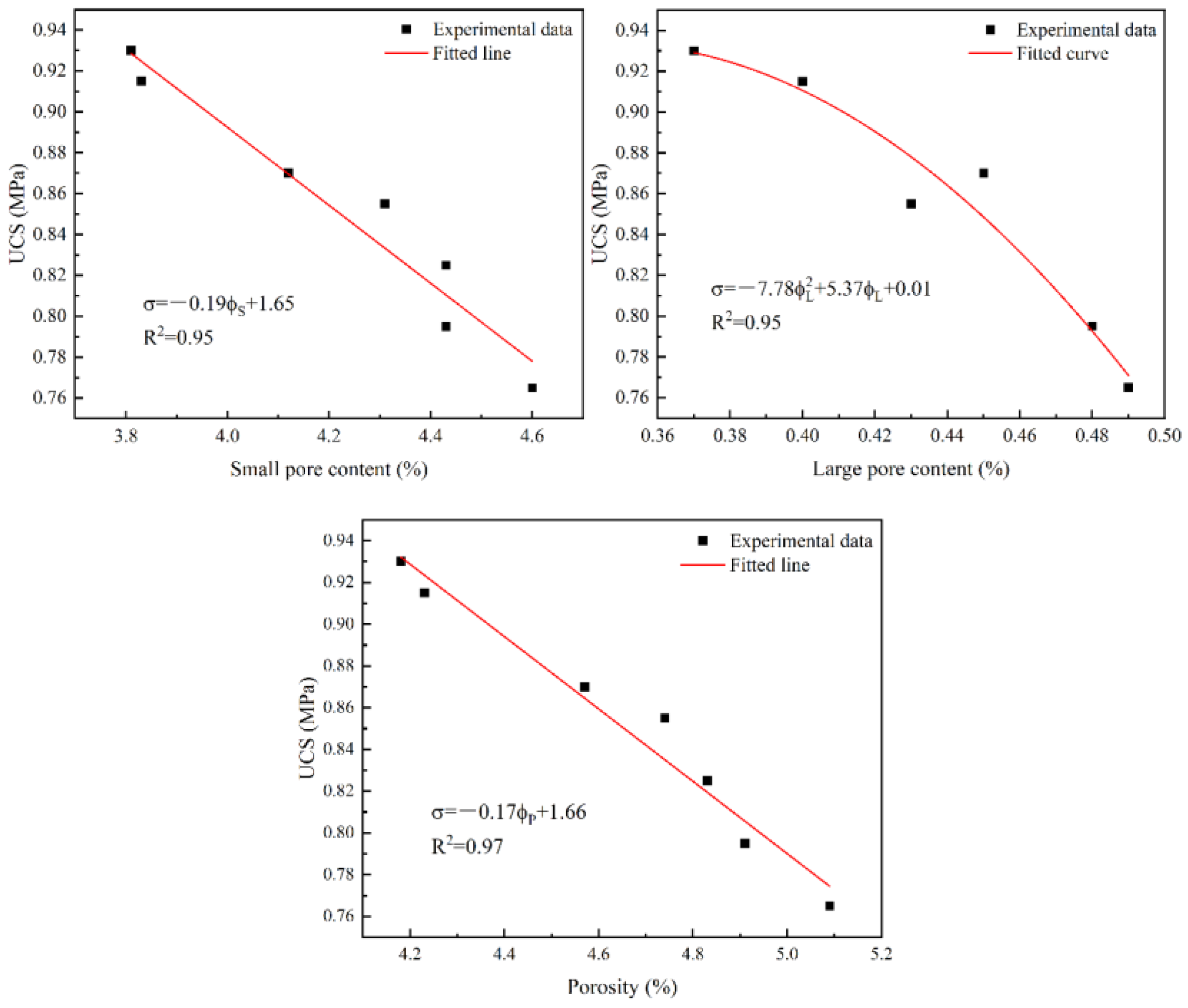

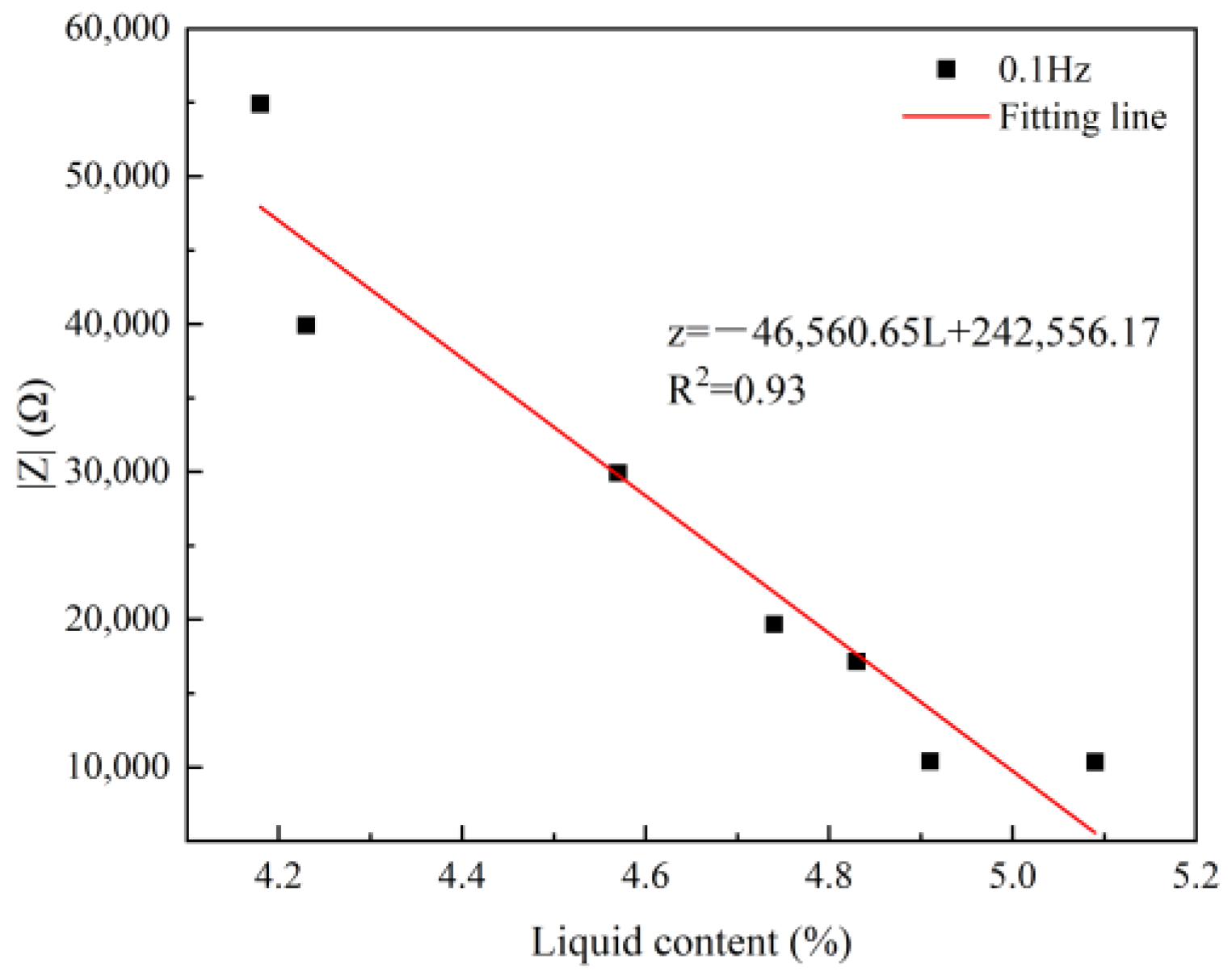

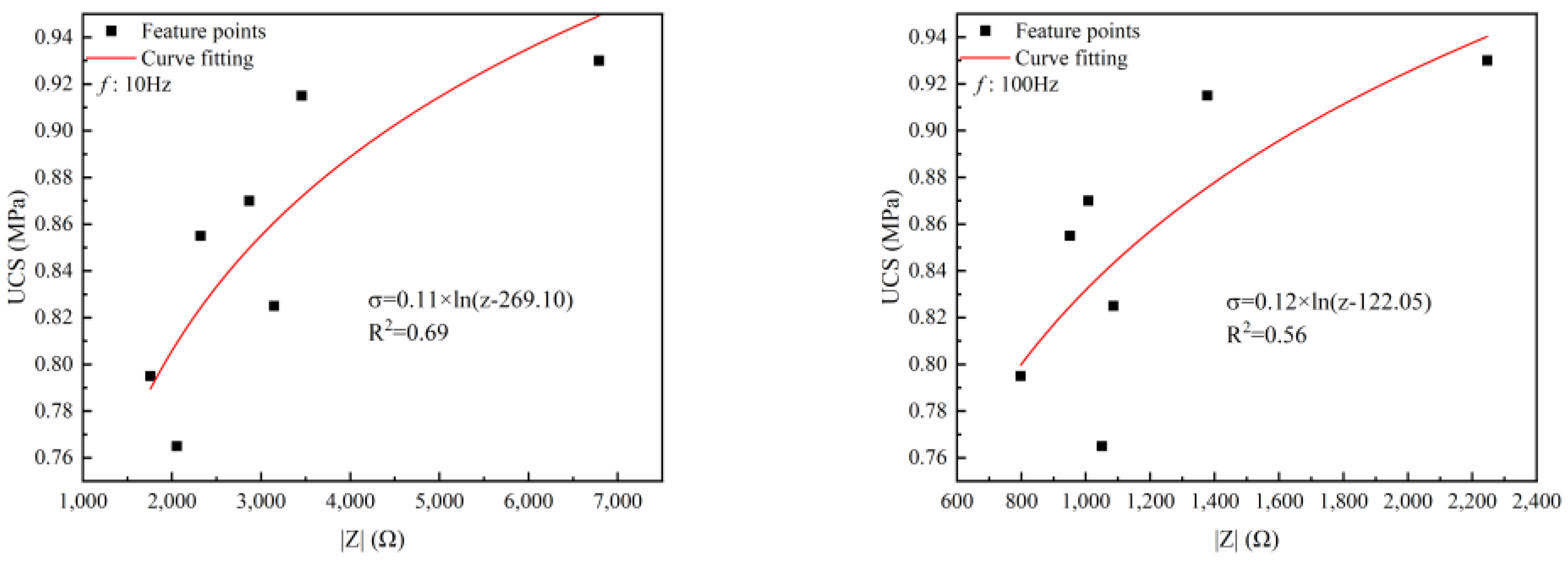
| Element | O | Ca | Si | Al | Fe | Mg | S | F | Other |
|---|---|---|---|---|---|---|---|---|---|
| PG | 36.96 | 35.07 | 4.27 | 0.41 | 0.57 | 0.14 | 21.09 | 0.33 | 1.16 |
| FA | 33.89 | 5.89 | 28.24 | 16.18 | 8.11 | 0.80 | 1.38 | 0.27 | 5.24 |
| Particle Size/mm | Mass Fraction/% | Mass Accumulation/% |
|---|---|---|
| 0.00−0.28 | 25.00 | 25.00 |
| 0.28−1.25 | 19.50 | 44.50 |
| 1.25−2.00 | 20.25 | 64.75 |
| 2.00−3.00 | 15.00 | 79.75 |
| 3.00−4.00 | 12.75 | 92.50 |
| 4.00−5.00 | 7.50 | 100 |
| Group | Lime/PG (%) | PG Content (%) | FA Content (%) | Mass Percentage | Cement–Crushed Stones Ratio |
|---|---|---|---|---|---|
| A0 | 0 | 20 | 5.9 | 80% | 1:8 |
| A1 | 0.2 | ||||
| A2 | 1 | ||||
| A3 | 1.8 | ||||
| A4 | 2.6 | ||||
| A5 | 3.4 | ||||
| A6 | 4.2 |
Disclaimer/Publisher’s Note: The statements, opinions and data contained in all publications are solely those of the individual author(s) and contributor(s) and not of MDPI and/or the editor(s). MDPI and/or the editor(s) disclaim responsibility for any injury to people or property resulting from any ideas, methods, instructions or products referred to in the content. |
© 2024 by the authors. Licensee MDPI, Basel, Switzerland. This article is an open access article distributed under the terms and conditions of the Creative Commons Attribution (CC BY) license (https://creativecommons.org/licenses/by/4.0/).
Share and Cite
Liu, X.; Wang, W.; Han, Z. Experimental Study on Influence of Lime on Cross-Scale Characteristics of Cemented Backfill with Multiple Solid Wastes. Materials 2024, 17, 4090. https://doi.org/10.3390/ma17164090
Liu X, Wang W, Han Z. Experimental Study on Influence of Lime on Cross-Scale Characteristics of Cemented Backfill with Multiple Solid Wastes. Materials. 2024; 17(16):4090. https://doi.org/10.3390/ma17164090
Chicago/Turabian StyleLiu, Xiaosheng, Weijun Wang, and Zhengwei Han. 2024. "Experimental Study on Influence of Lime on Cross-Scale Characteristics of Cemented Backfill with Multiple Solid Wastes" Materials 17, no. 16: 4090. https://doi.org/10.3390/ma17164090





